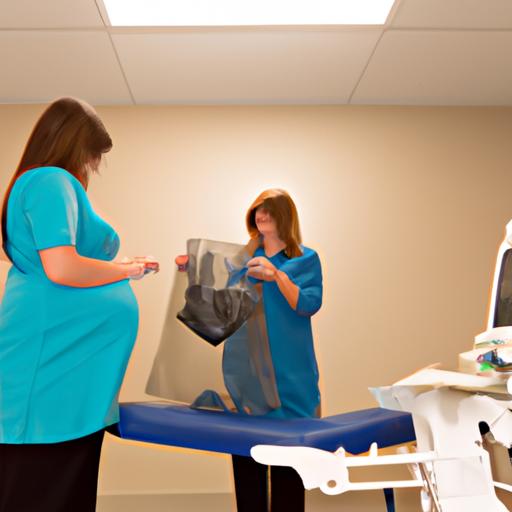Discover the truth about dental x-ray during pregnancy side effects. Learn about safety, precautions, and guidelines for optimal oral health.
Introduction
When it comes to maintaining good oral health, it’s important not to neglect dental care during pregnancy. Regular visits to the dentist are crucial, but concerns may arise when it comes to dental x-rays during pregnancy and their potential side effects. In this article, we will explore the safety of dental x-rays, the potential side effects they may pose, and the precautions you can take to ensure both your dental health and the well-being of your baby.

A dental healthcare professional ensuring the safety of dental x-rays during pregnancy.
Safety of Dental X-Rays during Pregnancy
Dental x-rays are an essential diagnostic tool that allows dentists to identify potential oral health issues that may not be visible during a regular examination. One common concern is the exposure to radiation during dental x-rays. However, it’s important to note that dental x-rays use low levels of radiation, making them generally safe for pregnant women.
The radiation exposure from dental x-rays is significantly lower compared to other sources such as medical imaging procedures. For instance, a dental x-ray exposes you to about 0.005 millisieverts (mSv) of radiation, whereas a mammogram exposes you to approximately 0.4 mSTo put things into perspective, the average person is exposed to about 2 mSv of radiation annually from natural sources like the sun and soil. Rest assured, the risks associated with dental x-rays during pregnancy are considered minimal.

A bitewing x-ray providing detailed information about dental health during pregnancy.
Potential Side Effects of Dental X-Rays during Pregnancy
To better understand the potential side effects of dental x-rays during pregnancy, it’s important to examine the different types of dental x-rays commonly used.
1. Bitewing X-Rays
Bitewing x-rays are commonly used to detect cavities between the teeth and monitor the progression of existing dental restorations. The radiation exposure from bitewing x-rays is extremely low, and the beam is focused on the teeth and surrounding areas, minimizing exposure to the abdomen.
2. Periapical X-Rays
Periapical x-rays provide a detailed view of individual teeth, including the roots and surrounding bone. Similar to bitewing x-rays, the radiation exposure from periapical x-rays is localized to the oral cavity, reducing the potential risk to the developing fetus.
3. Panoramic X-Rays
Panoramic x-rays provide a broader view of the entire oral cavity, including the teeth, jaws, sinuses, and temporomandibular joints. Although panoramic x-rays expose a larger area to radiation, the exposure is still minimal and highly unlikely to cause any harmful effects during pregnancy.

Taking precautions with a lead apron to protect the pregnant woman during dental x-rays.
Precautions and Guidelines for Dental X-Rays during Pregnancy
While dental x-rays are generally considered safe during pregnancy, it’s important to take certain precautions to ensure the well-being of both you and your baby. Here are some guidelines recommended by dental professionals:
1. Open Communication with Dental Healthcare Providers
Inform your dentist about your pregnancy as soon as possible. This will allow them to take additional precautions and discuss alternative diagnostic options, if necessary. Your dental healthcare provider will be able to assess your oral health needs and make informed decisions regarding the timing and necessity of dental x-rays.
2. Recommended Timing for Dental X-Rays during Pregnancy
If a dental x-ray is deemed necessary, it is generally recommended to schedule it during the second trimester. At this stage, the baby’s organs are already formed, reducing the potential risks associated with radiation exposure. However, if urgent dental treatment is required during the first or third trimester, the benefits of diagnosing and treating oral health issues may outweigh the minimal risks of radiation exposure.
3. Utilization of Lead Aprons and Thyroid Collars for Protection
During dental x-rays, your dental healthcare provider will take measures to minimize radiation exposure. They will provide you with a lead apron to shield your abdomen and a thyroid collar to protect your thyroid gland. These protective devices act as barriers, further reducing any potential risks associated with radiation.
4. Alternative Diagnostic Options for Pregnant Women
In some cases, your dentist may explore alternative diagnostic options that do not involve radiation, such as visual examinations, dental history reviews, and using other diagnostic tools like intraoral cameras. These alternatives can provide valuable information without the need for x-rays.
Conclusion
Maintaining good dental health during pregnancy is vital, and dental x-rays can play a crucial role in identifying and addressing oral health issues. The safety of dental x-rays during pregnancy has been extensively studied, and the risks associated with radiation exposure are considered minimal. By following the guidelines provided by your dental healthcare provider and taking necessary precautions, you can ensure both your dental health and the well-being of your baby.
Remember, open communication with your dentist is key. They have the expertise to determine the necessity of dental x-rays and will take every precaution to minimize any potential risks. So, don’t hesitate to prioritize your oral health and seek the necessary dental care during pregnancy. Your beautiful smile is worth it!
Tips and Guide for Maintaining Dental Health during Pregnancy
Disclaimer: The information provided in this article is for educational purposes only and should not be considered as a substitute for professional medical advice. Always consult with your healthcare provider or dentist for personalized guidance and recommendations.







